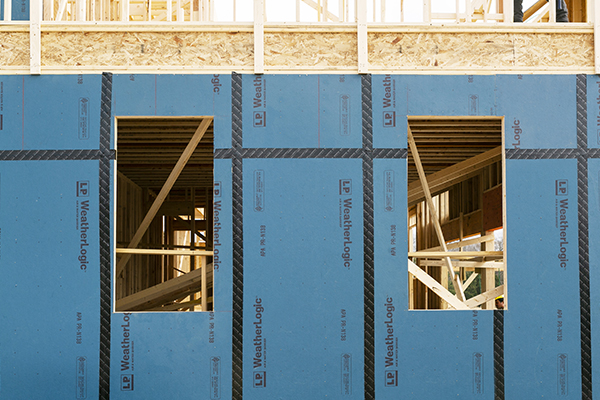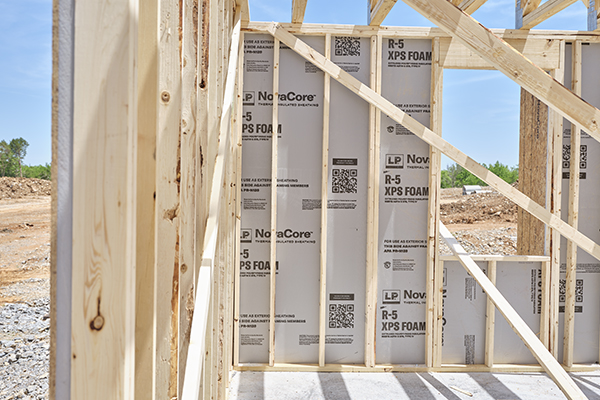Business Advice10 min
Building Science: The Secret Weapon for Transforming Your Construction Business
As a builder, you're always looking for ways to improve your craft and take your business to the next level. Using building science principles can help you approach construction design challenges differently, helping deliver a more comfortable and efficient home to your customer. We caught up with LP Building Science Manager Neil Freidberg to get his perspective on what building science in construction is and to get his advice to help you transform your construction business.
What Is Building Science in Construction?
Building science studies how buildings work and function as a system. While it's a multidisciplinary field that focuses on heat transfer and moisture, it draws on physics, engineering and architecture to create houses that are energy efficient, durable and comfortable for their occupants.
By incorporating building science into your work you can construct homes that use less energy and have better indoor air quality, which allows you to offer a high-quality home that stands out in the community.
Why Is Building Science Important and How Can It Transform Your Business?
Whether applied to a passive home that maximizes energy efficiency, a resilient home or a simply comfortable home with pleasant temperatures and healthy indoor air, building science looks at the home as an entire system rather than a collection of individual products. Building science is important because it helps builders construct a more energy-efficient, durable and comfortable structure.
Building science principles also look at the home's performance holistically. "Building science is more than building for the climate zone; we have to be very specific about house style and even the building site," says Freidberg.
The Importance of Knowing the Science Behind the Build
While building science studies the house as a group of systems, it also examines how elements of these systems can affect one another—even if they are on the other side of the house.
For example, it may be hard to believe at first, but slab construction can affect a home’s durability and airflow.
"When I work with a builder on slab-on-grade, I concentrate on any inconsistencies in the slab. Those natural waves are places I need to focus on air sealing around walls," says Freidberg.
"Next, we'll examine the soil, and if it's a termite-dense area I'll recommend pressure-treated wood or some sort of termite barrier. We need to address the air seal so it's as airtight as possible because that wood is going to be the foundation for where I put my sheathing."
Each situation leads to the next point to consider-even questioning the components to be used inside the house. "As we're making the house airtight, I'm asking if the homeowners are using a big range in the kitchen. I want to know if it uses combustible gas fuel or electricity. If so, I'm thinking about makeup air," says Freidberg.
An efficient way to help prevent air from coming into a home is to use an air barrier system like LP WeatherLogic® Air & Water Barrier and LP WeatherLogic Seam & Flashing Sealant or LP WeatherLogic Seam & Flashing Tape. As a system, these products help to reduce air leakage and moisture, and they help to provide a tighter building envelope.

Examples of Building Science Principles
While these are examples of building science principles that affect durability and airflow, building construction type and even the lot the house is built on can have an environmental impact.
For instance, building science examines airflow and hot and cool rooms. "Air sealing reduces drafts and cold walls around the house, improving energy efficiencies," says Freidberg. "If you have a good, sealed energy-efficient wall, you can see upwards of a 30%-40% reduction in energy costs on just the thermal load."
Another building construction design improvement you can use to impact your client's long-term efficiency is the location of the venting system. Will the ducts be in the attic, crawl space or basement? Or will the venting be in a conditioned space in a closet? This all affects the thermal load, HVAC capacities and how people will use their home.
Surprisingly, building science can also account for differences in energy efficiency and moisture between two houses situated in the same neighborhood. One could be built in the middle of a grove of trees while another stands apart on a bare lot. "We have to think about how trees provide shade during the summer and, more importantly, how vapor tends to flow differently in this wall versus that wall in the house exposed to full sunlight," says Freidberg.
In the wintertime, the north side of the house is likely to experience cold rooms unless attention is focused on adding insulation. Using a product like LP NovaCore™ Thermal Insulated Sheathing can reduce potential heat gain or loss through the studs, making a more comfortable house for homeowners.

Another way to understand the importance of building science is to see the connection between inside and outside spaces where cold air and moisture congregate, like an unconditioned basement or attached garage.
Even keeping the garage door closed doesn't stop moist air from coming in and settling into the space. Traditionally, homebuilders do not install an air barrier on the floor above, but it might be a good idea to do so in order to help control water vapor and moisture in the living area.
"Building a house is complex and using the wrong components could affect a home's performance," says Freidberg. "It's like wearing the wrong shoes. After a while it affects your knees, hips, back and neck, and it could affect the performance of your whole body."
Building science principles can transform your construction business by reducing energy costs, preventing moisture damage and improving indoor air quality, giving you an advantage in your business and offering clients a superior product they will appreciate for years to come.
Looking for more ways to take your business to the next level? Read how to shift your business plan by using premium building materials.
Continue Reading
Resiliency Solutions
5 minIntroducing LP® SmartSide® ExpertFinish® Naturals Collection™: Nature-Inspired Beauty Meets Engineered Performance
We’re excited to introduce the LP® SmartSide® ExpertFinish® Naturals Collection™, a bold new addition to our trusted line of engineered wood siding and trim that delivers the warmth and beauty of nature with the advanced protection and performance builders and homeowners expect.
Labor Solutions
5 minChoosing the Right LP® Structural Solutions Product for Your Build
When it comes to building strong, reliable, and high-performing structures, the materials you choose matter. At LP Building Solutions, we understand that every project, whether it's a single-family home or a multifamily development, requires structural components that meet your needs for strength, durability, and efficiency.
Sustainability Solutions
5 minBuilding a More Sustainable Future with LP Building Solutions
In today's world, sustainability is no longer just a buzzword, it's a blueprint for responsible living and smarter building. As the construction industry seeks ways to reduce its environmental footprint, LP Building Solutions is focused on providing innovative building materials for eco-conscious builders to help reshape what it means to build sustainably
News & Stories3 min
History of Partnership with Gary Sinise Foundation
The LP Foundation is a proud partner of the Gary Sinise Foundation, which supports wounded veterans in several ways. You can learn more about the LP Foundation here.